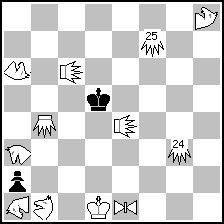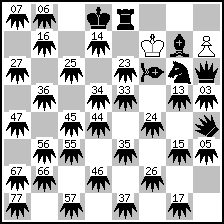|
| Page: [Previous] [Next] 1 2 |
| (1) Posted by Frank Richter [Tuesday, Jul 7, 2009 08:53] |
Problem with largest number of different fairy pieces and/or conditions?
Just a simple question, who likes to post such a problem (please without any discussion regarding the quality)?
|
|
| (2) Posted by Joost de Heer [Tuesday, Jul 7, 2009 10:41] |
Hans Burbach
Probleemblad 200? (I can't find the issue right now in which this was published, it was in the column 'Taakjes')
 (= 8+56 ) (= 8+56 )
How many moves? ( : 56 different fairy pieces) : 56 different fairy pieces)
|
|
| (3) Posted by Jacques Rotenberg [Wednesday, Jul 8, 2009 08:31]; edited by Jacques Rotenberg [09-07-08] |
well...
let's try to answer :
you have 7x2 moves of pawns
you may think that for each pawn move you have 56+4=60 possible promotions with a total of
7x2x60 moves.
But you may go further :
you may add stipulations that will increase this such as Circe pieces, paralysing pieces and so on
You may say that the pawns themselves have more moves, so that they will be able to promote, each, on any square of the 8th raw, or even on any square of the board! (or even on any board!)
and so on
|
|
| (4) Posted by Sarah Hornecker [Wednesday, Jul 8, 2009 08:52]; edited by Sarah Hornecker [09-07-08] |
I remember a masterpiece by Yoshikazu Ueda. It was reprinted in some MPR issue and had lots of fairy pieces.
I think that's more "true" than just giving random fairy pieces.
|
|
| (5) Posted by Thomas Maeder [Wednesday, Jul 8, 2009 11:46] |
Manfred Rittirsch published such a problem in feenschach around 1990, IIRC.
Among the fairy pieces was one named Hans Gruber and one named Brigitte Bardot; the latter has some paralysing effect on the former (again, IIRC).
|
|
| (6) Posted by Kevin Begley [Wednesday, Jul 8, 2009 22:41]; edited by Kevin Begley [09-07-08] |
I have composed a problem with an infinite number of different fairy pieces (on an infinite board, to obtain a Zilahi Cycle -- plus a few other cyclic effects -- of infinite proportion).
[edit: The infinite number of fairy pieces = Camel, Girafe, (1,5)Leaper, (1,6)Leaper, (1,7)Leaper, ... (1,n)Leaper]
I consider it infinitely unworthy of publication.
In fact, I wouldn't even mention it, except that its unworthiness is only countably-infinite.
Had I not seen a few problems of an unworthiness beyond the uncountable-infinity (hey, some even won awards!), I would never admit to having burried what can be properly regarded as Frankenstein's work.
|
|
| (7) Posted by Bojan Basic [Thursday, Jul 15, 2010 18:24] |
QUOTE
I remember a masterpiece by Yoshikazu Ueda. It was reprinted in some MPR issue and had lots of fairy pieces.
Although the topic is not active anymore, I believe this is what you were talking about.
Yoshikazu Ueda
Problem Paradise 2005
 (= 11+3 ) (= 11+3 )
ser-h#2
) = Grasshopper = Grasshopper
) = Locust = Locust
) = Nightrider-hopper = Nightrider-hopper
) = Zebra = Zebra
) = Camelrider = Camelrider
) = Giraffe = Giraffe
) = Antelope = Antelope
) = (2,4)-leaper = (2,4)-leaper
) = (2,5)-leaper = (2,5)-leaper
) = Non-stop Equihopper = Non-stop Equihopper
12.1.1
Solution:
1.a2*b1=S 2.Sb1-c3 + Lc6*c3-c2 #
1.a2*b1=B 2.Bb1-d3 Le4*d3-c2 #
1.a2*b1=G 2.Gb1-f5 Le4*f5-g6 #
1.a2*b1=L 2.Lb1*b4-b5 Lc6*b5-a4 #
1.a2*b1=NH 2.NHb1-e7 Le4*e7-e8 #
1.a2*b1=Z 2.Zb1-d4 Le4*d4-c4 #
1.a2*b1=CR 2.CRb1-d7 Lc6*d7-e8 #
1.a2*b1=GI 2.GIb1-c5 + Lc6*c5-c4 #
1.a2*b1=AN 2.ANb1-e5 Le4*e5-e6 #
1.a2*b1=24 2.24b1-f3 Le4*f3-g2 #
1.a2*b1=25 2.25b1-d6 Lc6*d6-e6 #
1.a2*b1=NE 2.NEb1-b7 Lc6*b7-a8 #
|
|
| (8) Posted by Sarah Hornecker [Thursday, Jul 15, 2010 18:45] |
No, it used all kinds of different pieces (hoppers from 0-1 to 7-6 or the like), and the board was almost full.
|
|
| (9) Posted by Administrator [Thursday, Jul 15, 2010 20:05] |
Perhaps this one:
Yoshikazu Ueda
F232 Problem Paradise 32/2004
1-3.pr Problem Paradise 2004
 (= 2+36 ) (= 2+36 )
ser-!=2 (35 sol.), Andernach
Rook-Kangaroo on h4, Vao on f6 and many leapers with given coordinates give a total of 31 different fairy pieces.
Solutions:
1.h8=Q 2.Qxh6(bQ)!=
1.h8=R 2.Rxe8(bR)!=
1.h8=B 2.Bxg7(bB)!=
1.h8=S 2.Sxg6(bS)!=
1.h8=L03 2.L03xh5(bL03)!=
1.h8=L05 2.L05xh3(bL05)!=
1.h8=L06 2.L06xb8(bL06)!=
1.h8=L07 2.L07xa8(bL07)!=
1.h8=L13 2.L13xg5(bL13)!=
1.h8=L14 2.L14xd7(bL14)!=
1.h8=L15 2.L15xg3(bL15)!=
1.h8=L16 2.L16xb7(bL16)!=
1.h8=L17 2.L17xg1(bL17)!=
1.h8=L23 2.L23xe6(bL23)!=
1.h8=L24 2.L24xf4(bL24)!=
1.h8=L25 2.L25xc6(bL25)!=
1.h8=L26 2.L26xf2(bL26)!=
1.h8=L27 2.L27xa6(bL27)!=
1.h8=L33 2.L33xe5(bL33)!=
1.h8=L34 2.L34xd5(bL34)!=
1.h8=L35 2.L35xe3(bL35)!=
1.h8=L36 2.L36xb5(bL36)!=
1.h8=L37 2.L37xe1(bL37)!=
1.h8=L44 2.L44xd4(bL44)!=
1.h8=L45 2.L45xc4(bL45)!=
1.h8=L46 2.L46xd2(bL46)!=
1.h8=L47 2.L47xa4(bL47)!=
1.h8=L55 2.L55xc3(bL55)!=
1.h8=L56 2.L56xb3(bL56)!=
1.h8=L57 2.L57xc1(bL57)!=
1.h8=L66 2.L66xb2(bL66)!=
1.h8=L67 2.L67xa2(bL67)!=
1.h8=L77 2.L77xa1(bL77)!=
1.h8=RKa 2.RKaxh4(bRKa)!=
1.h8=VA 2.VAxf6(bVA)!=
Comments by Vlaicu Crisan in MPR 5 (2008):
"All solutions can be written in condensed form: 1.h8=Y 2.YxY(bY)!=, where Y is any black piece. The constitution of the idea is very simple: the promoted piece on h8 must capture a black piece in order to change colour and hence force the autostalemate. This task also shows the Anti-Phoenix theme (first promotion, then capture of like piece). 35 is the promotion record number to date. Can anyone beat this record?"
|
|
| (10) Posted by Sarah Hornecker [Thursday, Jul 15, 2010 20:23] |
Yes, this is it. Thanks!
|
|
| (11) Posted by seetharaman kalyan [Thursday, Jul 15, 2010 21:21]; edited by seetharaman kalyan [10-07-15] |
I think the problem can be economized and the record bettered. As the French demonstrated, Removing the White King makes things simpler! Further move Rook to f8 and Move BK to c8 (or any other place). Add Nightrider f7, 04 leaper at d8, a Pao at e8 and an Equiphopper at d6.
39 solutions. Autostalemate in one. Madrasi !!
|
|
| (12) Posted by Kevin Begley [Thursday, Jul 15, 2010 22:13]; edited by Kevin Begley [10-07-15] |
Seems to me that this "record" can be far surpassed, with better economy.
scheme (sans voir)
 (= 3+1 ) (= 3+1 )
Anti-Andernach
auto=1 (uncountable solutions)
Now, just add a few billion fairy pieces, below the diagram -- they needn't even be on the board.
1.h8~(black ~) auto=!
I suppose we should assume that the judge was referring to an "anti-phoenix promotion record."
|
|
| (13) Posted by seetharaman kalyan [Thursday, Jul 15, 2010 22:44]; edited by seetharaman kalyan [10-07-15] |
I have just one doubt. Is it stalemate when white has moved last and it is black turn to play? I think only those problems where black cannot release the stalemate should be considered correct. On that reasoning, even the quoted problem of Mr.Yoshikazu Ueda, is not sound.
My suggested version does not suffer from this defect !!
|
|
| (14) Posted by Kevin Begley [Thursday, Jul 15, 2010 23:08]; edited by Kevin Begley [10-07-16] |
@seetharaman kalyan:
>Is it stalemate when white has moved last and it is black turn to play, so can he not relieve the stalemate?
No, there is no defect.
The stipulation is "!=" (auto-stalemate)... same as it is in Ueda's 35-solution problem (except he prefixes with a short series-mover).
Black has no chance to move in !=1 (same goes for ser.!=n).
The goal of auto-stalemate is to stalemate yourself, prior to the opponent's next move (unlike stalemate, which can only happen after).
btw: it is trivial to surpass Ueda's "anti-phoenix promotion record," as well...
|
|
| (15) Posted by seetharaman kalyan [Friday, Jul 16, 2010 07:36] |
True. It is trivial to try and surpass this record. That is why I started with removing white King !!
|
|
| (16) Posted by Vlaicu Crisan [Saturday, Jul 17, 2010 10:55] |
Challenge: I offer to publish in Problem Paradise any correct setting beating Yoshikazu Ueda's record!
Attention: problems with dualistic second moves will be rejected.
|
|
| (17) Posted by Kevin Begley [Saturday, Jul 17, 2010 20:01] |
@Vlaicu,
Can you please specify what exactly it is you consider this "record" to be?
Is the record merely a super-AUW w/ the highest quantity of promotion types?
Or, is the anti-phoenix an inherent component of this record?
Thanks.
|
|
| (18) Posted by Vlaicu Crisan [Sunday, Jul 18, 2010 07:22] |
To set the task simple: maximum number of promotions in serial autostalemate in 2, Andernach.
The greatest the number of Anti-Phoenix variations, the better the task!
|
|
| (19) Posted by Cornel Pacurar [Sunday, Jul 18, 2010 09:26] |
@ Vlaicu: I was just about to post something starting with "If, besides Andernach, extra fairy conditions are permitted" when you posted your last message! But now, as you only limited the fairy conditions (to Andernach only, that is), not those "few billion fairy pieces" mentioned above, one still could extend without much effort Yoshikazu's record to at least 58 (or so it seems!) promotions and Anti-Phoenix variations, by using this very matrix. Here is a recipe: the white unit at h7 (which happens to be a pawn!...) can only capture black units of the same type (does such a piece have a name yet?!). Next, carefully add distinct combined leapers on all empty squares of Yoshikazu's diagram position except f8, g8 and h8! For example, with a Bison (1,3 + 2,3 leaper) at f5, the special pawn h7 would need to promote to Bison in order to be able to capture at f5, while it would still need to promote to Camel (1,3 leaper) and, respectively, to Zebra (2,3 leaper) in order to be able to capture at g5 and, respectively, e6! Otherwise, Yoshikazu's composition seems to be as good as it gets! :-)
|
|
| (20) Posted by seetharaman kalyan [Sunday, Jul 18, 2010 22:16]; edited by seetharaman kalyan [10-07-18] |
I wonder why he didnt use a 1,5 Leaper for another solution 1.ab 1,5L 2.1,5L g2 ; L*g2 h1#
|
|
Read more... |
Page: [Previous] [Next] 1 2
MatPlus.Net  Forum Forum  Promenade Promenade  Problem with largest number of different fairy pieces and/or conditions? Problem with largest number of different fairy pieces and/or conditions? |
 ISC 2024
ISC 2024 Forum
Forum  Promenade
Promenade  Problem with largest number of different fairy pieces and/or conditions?
Problem with largest number of different fairy pieces and/or conditions? 


